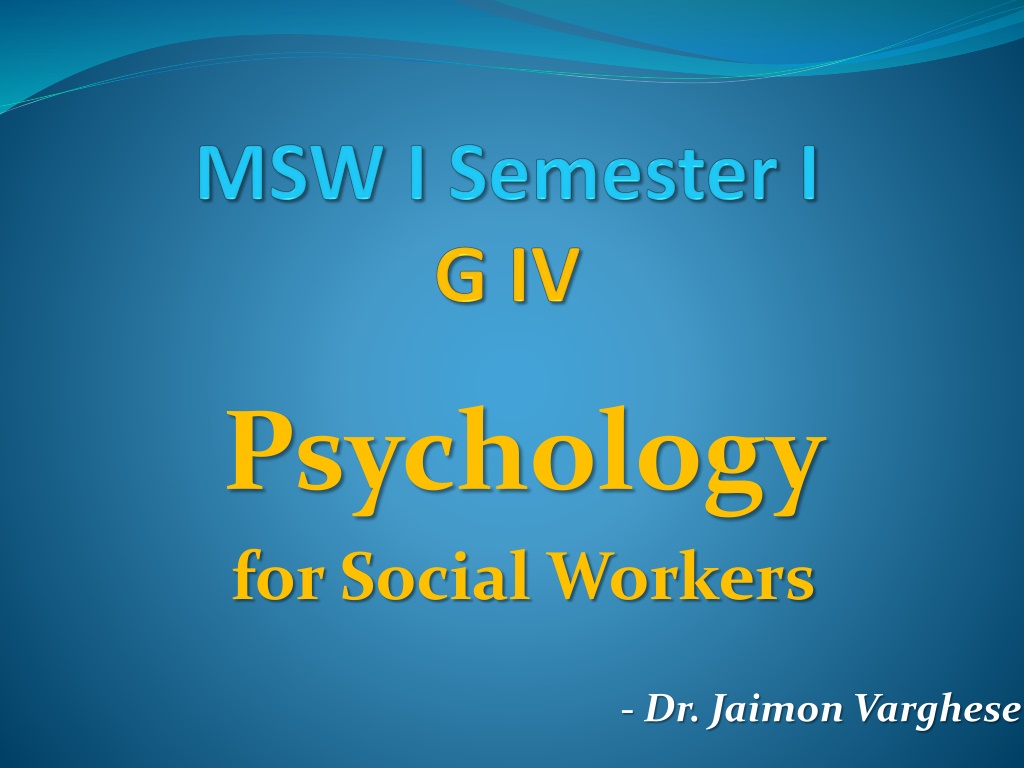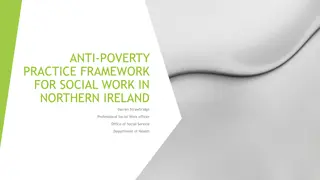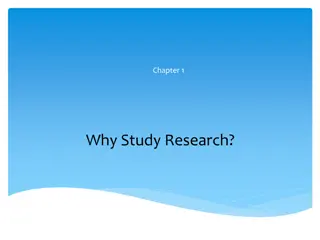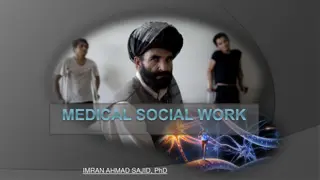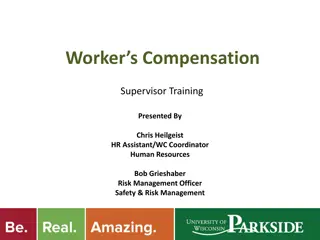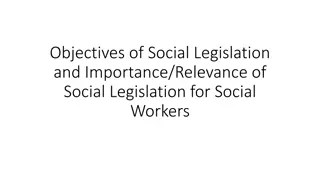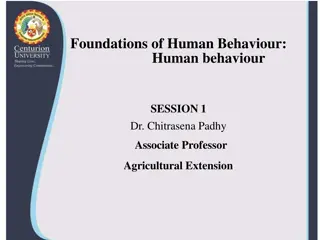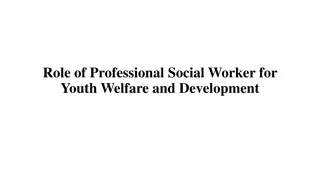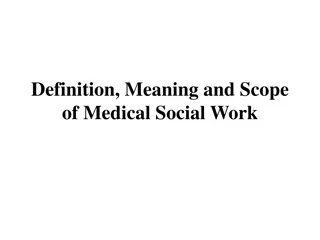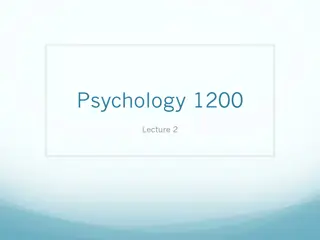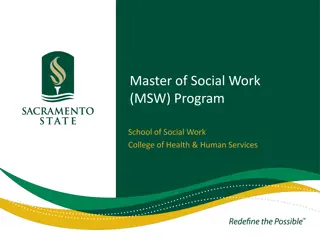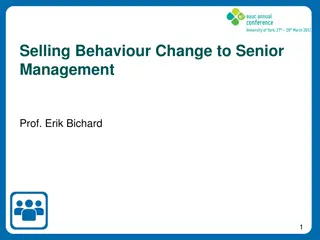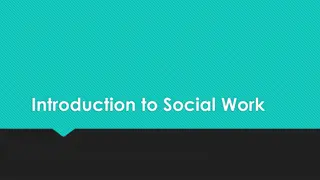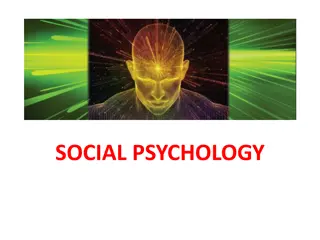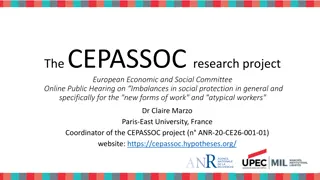Understanding Human Behavior: Insights for Social Workers
This material delves into the intricacies of human behavior, exploring factors influencing behavior such as heredity, environment, intelligence, needs, and motives. It covers the concept of human behavior, stages in life from conception to old age, and theories of human development by eminent psychologists like Freud and Erickson. The content also discusses the various types of human behavior including physical, cognitive, emotional, and social behavior, shedding light on conscious, subconscious, and unconscious behavior patterns.
Download Presentation

Please find below an Image/Link to download the presentation.
The content on the website is provided AS IS for your information and personal use only. It may not be sold, licensed, or shared on other websites without obtaining consent from the author. Download presentation by click this link. If you encounter any issues during the download, it is possible that the publisher has removed the file from their server.
E N D
Presentation Transcript
Psychology for Social Workers - Dr. Jaimon Varghese
2. Human Behaviour 2.1. Concept of Human Behavior 2.2 Factors influencing Human behaviour: 2.2.1 Heredity, 2.2.2 Environment, 2.2.3 Intelligence, 2.2.4 Needs, 2.2.5 Motives 11-09-2024 01:52:24 Psychology for Social Workers 2
2. Human Behaviour 2.3. Characteristics, needs, tasks & problems of Stages in life from conception to old age 2.4. Theories of Human Development- 2.4.1 Freud s Psycho- Analytical Theory, 2.4.2 Erickson s Psycho-Social Theory 11-09-2024 01:52:24 Psychology for Social Workers 3
2.1. Concept of Human Behaviour Behavior means any observable action or reaction of a living organism-everything from overt actions (anything we say or do) through subtle changes in the electrical activity occurring deep inside our brains (covert). If it can be observed and measured, then it fits within the boundaries of psychology. Similarly, by cognitive processes, psychologists mean every aspect of our mental life-our thoughts, memories, mental images, reasoning, decision making, and so on- in short, all aspects of the human mind 11-09-2024 01:52:24 Psychology for Social Workers 4
2.1. Concept of Human Behaviour Physical (Psychomotor) behaviour Cognitive (Mental / Intellectual) behaviour Emotional (affective) behaviour Social behaviour Conscious, sub conscious and unconscious behaviour Verbal and non verbal behaviour Overt (open) and covert (hidden) behaviour 11-09-2024 01:52:24 Psychology for Social Workers 5
2.2 Factors Influencing Human Behaviour 2.2.1 2.2.2 2.2.3 2.2.4 2.2.5 Heredity, Environment, Intelligence, Needs, Motives 11-09-2024 01:52:24 Psychology for Social Workers 6
2.2.1. Heredity Biological determinants or genetic features of human development and human behaviour inherited from parents to children and runs through generations In biology, heredity refers to the genetic transmission of biological characteristics from a parent organism to offspring. Heredity is the sum of characteristics and associated potentialities transmitted genetically to an individual organism. Genes are the carriers of biological information. 11-09-2024 01:52:24 Psychology for Social Workers 7
2.2.1. Heredity High heritability coefficient does NOT mean unchangeable e.g. height and nutrition, or intelligence and environment Hereditary and genetic influences are two separate mechanisms Heritability does not address mechanisms of genetic influence All the hereditary influences (excluding social or cultural inheritance such as religion, mother tongue etc.) are genetic; however, all the genetic factors are not hereditary (birth abnormalities) 11-09-2024 01:52:24 Psychology for Social Workers 8
2.2.1. Heredity Human body - human cell nucleus 23 pairs of chromosomes (which determines human species) 23rd pair of chromosomes (XY) decides the gender of the child Since Y chromosome is found only in male species, it is the father who decides the gender of the child The Human Genome: Each gene consists of a set of Deoxyribo Nucleic Acid sequences Vast majority of our genes are identical, non-identical ones influence variation among people in physical and also some psychological characteristics 11-09-2024 01:52:24 Psychology for Social Workers 9
2.2.1. Heredity Charles Darwin proposed a theory of evolution in 1859. Darwin believed in a mix of blending inheritance and the inheritance of acquired characteristics. Francis Galton, who laid the framework for the biometric school of heredity rejected the aspects of Darwin's pangenesis model which relied on acquired characteristics The idea of particulate inheritance of genes can be attributed to the Austrian monk Gregor Mendel who published on pea plants in 1865 11-09-2024 01:52:24 Psychology for Social Workers 10
2.2.1. Heredity The law of segregation (Mendel's first law) states that in the process of the formation of the gametes the pairs separate, one going to each gamete, and that each gene remains completely uninfluenced by the other. The law of independent assortment (Mendel's second law) states that characteristics are inherited independently of each other; e.g., the dominant trait of yellow seed color in pea plants can appear in combination with either the dominant trait of plant tallness or the recessive trait of dwarfness. 11-09-2024 01:52:24 Psychology for Social Workers 11
2.2.1. Heredity Mendel found that when a pure strain of peas bearing one form of a gene (that is, a strain in which both members of the gene pair being studied are the same), inbred for many generations, was crossed with a pure strain carrying an alternative form of the gene, one of these forms consistently prevailed over the other in determining the visible characteristics of the offspring; he therefore termed the two forms dominant and recessive, and called the phenomenon itself the law of dominance. 11-09-2024 01:52:24 Psychology for Social Workers 12
2.2.1. Heredity Height, body structure, colour of skin, hair and eyes, colour blindness, HIV Intelligence (arithmetic and linguistic), aesthetics (music, arts, crafts and sports), susceptibility to illness (AIDS, asthma, depression and psychoses like schizophrenia) and temperament (partially) Certain human characteristics are genetic, but not hereditary: gender (male or female), mental retardation, corollary abnormalities, mono zygotic twins, physical disabilities (physical, visual, hearing or speech impairment and cerebral palsy) and several other physical disorders 11-09-2024 01:52:24 Psychology for Social Workers 13
2.2.1. Heredity Studies on extraversion and neuroticism show moderate genetic influence Similarly emotionality (intensity and type), sociability and activity level (intensity and tempo) have also some degree of genetic influence Genetic component is found for shyness and empathy Some genetic component for attitudes and beliefs, particularly traditionalism. Aggressive and altruistic tendencies are moderately hereditary (Mono Zygotic twins more similar than Di-Zygotic twins) 11-09-2024 01:52:24 Psychology for Social Workers 14
2.2.1. Heredity No genetic influence is there on character, illness like cancer, leprosy, diabetes, corollary diseases, mental retardation (genetic, but not hereditary), alcoholism, morality, religious behaviour, language (mother tongue), culture (culture is social inheritance), knowledge and social skills (leadership, management, romantic love) Heredity is an important influence, but not near 100%, on personality Non-genetic influences are clearly and equally important in personality Heredity and Environment INTERACT prior to any human behaviour 11-09-2024 01:52:25 Psychology for Social Workers 15
2.2.2. Environment One of the assumptions of behaviourist thought is that behaviour is determined not by heredity but by the environment either through association (conditioning), reinforcement (reward & punishment), imitation, observation, modelling, behaviour modification and learning. 11-09-2024 01:52:25 Psychology for Social Workers 16
2.2.2. Environment Prenatal environment: malnutrition, medication, injuries Childbirth: oxygen, birth disorders (injuries) Post natal environment: malnutrition, immunisation, medication, illness Physical environment (geographical and climatic features) Social, political and economic environment 11-09-2024 01:52:25 Psychology for Social Workers 17
2.2.2. Environment Early childhood and family environment: siblings, peers, care givers (parents, grand parents, significant elders) School environment Occupational environment Marriage and in laws home environment 11-09-2024 01:52:25 Psychology for Social Workers 18
2.2.2. Environment Neighbourhood, school, occupational, institutional (kinship, religion, organisational and political) environment and their influence in affecting human development and moulding human personality Social roles, status, social competence and leadership Social perception, cultural and ethnic prejudices, stereotyping and personality development Mass and crowd behaviour Group dynamics 11-09-2024 01:52:25 Psychology for Social Workers 19
2.2.2. Environment Rumour, propaganda, lobbying and advocacy Social action and social movements: campaigning, self help group Reformation, revolution and community organisation Values, norms and culture to shape human personality Poverty, unemployment and illiteracy their impact on personality development 11-09-2024 01:52:25 Psychology for Social Workers 20
2.2.2. Environment Political influences, party politics, political crises, political movements, civil war and terrorism and their impact on personality development Urbanisation, corruption and crimes and their impact on personality Globalisation, migration, cosmopolitan culture and inter caste marriages and their impact 11-09-2024 01:52:25 Psychology for Social Workers 21
2.2.2. Environment Economic conditions of the state, region and neighbourhood and their impact on personality Stress and burnout: loss of loved ones, loss of employment, marital disputes, financial crisis, over work, compassion fatigue 11-09-2024 01:52:25 Psychology for Social Workers 22
2.2.2. Environment Natural and man made material environment Scarcity of natural resources Environmental and ecological factors: pollution (air, water, soil and noise) Geographical, climatic and economic (infra structure) environment Natural disasters and calamities and their impact on personality 11-09-2024 01:52:25 Psychology for Social Workers 23
2.2.2. Environment Housing conditions (home, school, factory, shop and office) Space, congestion, over crowding, squatter dwellings and slums Road, transportation and communication facilities of the region, village and neighbourhood Advanced scientific knowledge and corresponding civic amenities: central locking, theft alarm, automatic doors and water taps (with infrared sensing technology), locks with chip technology (i-cats), 11-09-2024 01:52:25 Psychology for Social Workers 24
2.2.2. Environment Technology: computer, internet, super sonic transportation, modern medical and diagnostic machinery, mass media and communication environment: mobile phone (3G) Distance and travel to work place Work environment and fatigue: light, sound, fresh air, heat, air conditioning, toilet and drinking water facilities 11-09-2024 01:52:25 Psychology for Social Workers 25
2.2.2. Environment Child rearing practices Gender typing (gender roles) Educational, occupational and social status of the parents and family Family traditions (traditional occupations) Class and caste of the family Marital disputes: misunderstandings, mistrust, legal disputes, dowry disputes 11-09-2024 01:52:25 Psychology for Social Workers 26
2.2.2. Environment Domestic violence Divorce and issues of child care Number of children / lack of children / adopted children Indiscipline, truancy and running away Presence of dependent members: persons with disabilities, infants, the elderly, the sick, the incurables Fatal sickness: cancer 11-09-2024 01:52:25 Psychology for Social Workers 27
2.2.2. Environment Medical treatment and financial crises Destitution Drug addiction Alcoholism of the chief earning members Working parents Role performance: Under achievement of children Family crises: failure in the performance of family duties 11-09-2024 01:52:25 Psychology for Social Workers 28
2.2.2. Environment Dissatisfaction and frustration in family life of the couples: issues related to impotency and infertility Loss of family members 11-09-2024 01:52:25 Psychology for Social Workers 29
2.2.3. Intelligence Intelligence is a significant factor of behaviour Intelligence is not satisfactorily defined; it is a combination of abilities and competencies Intelligence is the ability to learn (IQ); emotional competence (EQ); social competence (leadership); organisational ability (administration and management); spiritual and charismatic quality (ability to move people); artistic aptitudes, sports and crafts abilities; mechanical aptitudes (workmanship); ability for achievement (business); life skills 11-09-2024 01:52:25 Psychology for Social Workers 30
2.2.3. Intelligence IQ Test measures mainly arithmetic, logical and linguistic abilities that are suitable for learning; lower IQ does not mean that the person is socially, artistically, or spiritually incompetent Learning disabilities or learning abilities do not have any relationship with the life skills which explains why intellectually superior people sometimes fail in real life while people with average intelligence succeed in life Intelligence is normally distributed with majority in the average and a few in the bright or dull group IQ increases by age till 16-25 yrs, then stops vertically but expands horizontally with experience 11-09-2024 01:52:25 Psychology for Social Workers 31
2.2.3. Intelligence Intelligence means intellect put to use. It is the use of intellectual abilities for handling a situation or accomplishing any task (Woodworth & Marquis, 1948) Intelligence is a general capacity of an individual consciously to adjust his thinking to new requirements. It is general mental adaptability to new problems and conditions of life (Stern, 1914) Intelligence is the capacity to learn and adjust to relatively new and changing conditions (Wagnon, 1937) 11-09-2024 01:52:25 Psychology for Social Workers 32
2.2.3. Intelligence Intelligence is the power of good responses from the point of truth or fact (Thorndike, 1914) Intelligence is the aggregate or global capacity of an individual to act purposefully, to think rationally, and to deal effectively with his environment (Wechsler, 1944) Intelligence is the ability to undertake activities that are difficult, complex and abstract and which are adaptive to a goal, and are done quickly and which have social value and which lead to creation of something new and different (Stoddard, 1943) 11-09-2024 01:52:25 Psychology for Social Workers 33
2.2.3. Intelligence Intelligence may be regarded as a sort of mental energy in the form of mental or cognitive abilities available with an individual to enable him to handle his environment in terms of adaptation and facing novel situations as effectively as possible (Mangal SK, 1998:221) 11-09-2024 01:52:25 Psychology for Social Workers 34
2.2.3. Intelligence 1. Unitary theory or monarchic theory (outdated) Anarchic theory or multifactor theory (EL Thorndike) also named atomistic theory considers intelligence a combination of numerous separate elements of factors, each one being a minute element of an ability of an ability. 2. 3. Two factor theory of Spearman: Every different intellectual activity involves a general factor g which is shared with all intellectual activities and a specific factor s which it shares with none. 11-09-2024 01:52:25 Psychology for Social Workers 35
2.2.3. Intelligence 4. Group factor theory (Thurstone): 9 factors: Verbal (V), Spatial (S), Numerical (N), Memory (M), Word Fluency (W), Inductive Reasoning (RI), Deductive Reasoning (RD), Perceptual (P), and Problem solving (PS) 5. Hierarchical Theory of Vernon (1950): G is the most prominent mental ability measured through IQ tests. Under G , there are two main types of mental abilities, first being Ved Verbal, Numerical and Educational abilities and the second being KM practical, mechanical, spatial and physical abilities. Further each sub type is further divided into minor abilities down the hierarchy 11-09-2024 01:52:25 Psychology for Social Workers 36
2.2.3. Intelligence In Guilford's Structure of Intellect (SI) theory, intelligence is viewed as comprising operations, contents, and products. There are 5 kinds of operations (cognition, memory, divergent production, convergent production, evaluation), 6 kinds of products (units, classes, relations, systems, transformations, and implications), and 5 kinds of contents (visual, auditory, symbolic, semantic, behavioural). Since each of these dimensions is independent, there are theoretically 150 different components of intelligence. 6. 11-09-2024 01:52:25 Psychology for Social Workers 37
2.2.3. Intelligence Individual test and group tests Verbal (with language content) and non verbal (performance based or spatial / logical / pictorial content) tests Individual verbal IQ test: Stanford Binet Test (1960): first developed by French psychologists, Alfred Binet and Theodore Simon in 1905 consisting of 30 items like, at age 3 point out to nose, eyes and mouth; at age 7 tell what is missing in the unfinished picture . Adapted and revised in the USA at Stanford University in 1931 (by Terman), 1937 (by Maud A Merril) and finally in 1960 for age groups 2 to 22 years. 11-09-2024 01:52:25 Psychology for Social Workers 38
2.2.3. Intelligence Alfred Binet IQ Test was adapted to India for the first time in 1922 by Dr CH Rice Hindustani Binet Performance Scale . Stanford Binet Test has been translated to Hindi as Budhi Pariksha Anooshilan by the State Manovigyan Shala of UP Samanya Budhi Pariksha (part I & II), the Indian adaptation of William Stephenson s Verbal IQ Test has been prepared by State Bureau of Educational and Vocational Guidance, Gwalior, MP 11-09-2024 01:52:25 Psychology for Social Workers 39
2.2.3. Intelligence 1. Block building or cube construction 2. To fit the blocks in the holes 3. Tracing a maze 4. Picture arrangement or picture completion Popular Performance Tests: 1. The Pinter Patterson Scale, designed in the USA in 1917, a comprehensive test including 17 sub-tests 2. Arthur s Point Scale having 9 sub tests 3. Alexander s Battery of Performance Tests (Edinburg): 3 tests Pass-along, Block designs and cube construction 11-09-2024 01:52:25 Psychology for Social Workers 40
2.2.3. Intelligence 4. Bhatia s Battery of Performance Tests (Dr. Chander Mohan Bhatia): 5 subsets Koh s Block Design Test, Alexander s Pass-along test, Pattern Drawing Test, Immediate memory test for digits, Picture construction test 5. Wechsler bellevue Intelligence Scale for Children (WISC): both verbal and performance tests: Verbal scale General Information, General Comprehension, Arithmetic reasoning, distinction between similarities, digit span and vocabulary; Performance scale Digit & symbol, Picture completion, Block design, Picture arrangement, Object assembly. 11-09-2024 01:52:25 Psychology for Social Workers 41
2.2.3. Intelligence 1. Army Alpha Test (during World War I) 2. Army General Classification Test (World War II) 3. CIE verbal group test of Intelligence (Hindi) (Prof. Uday Shankar) 4. Samuhik Mansik Yogyata Pariksha (Dr. S Jalota) 5. Samuhik Budhi Pariksha (Mansayan, Delhi) 6. Samuhik Budhi Pariksha (Shri PL Shrimali, Vidya Bhavan, Udaipur) 7. Samuhik Budhi Ki Jaanch (Shri SM Mohsin, Edu. & Voc. Guidance Bureau, Patna) 8. General Mental Abilities Test (Punjabi) (Dr. PS Hundal, Punjab University) 9. Group verbal intelligence test (Malayalam) (Dr. P Gopala Pillai, Kerala University) 11-09-2024 01:52:25 Psychology for Social Workers 42
2.2.3. Intelligence 1. Army Beta Test (World War I for the US soldiers who were illiterate or non English speaking) 2. Chicago Non-verbal Test 3. Raven s Progressive Matrices Test 4. CIE nonverbal group test of intelligence, originally prepared by JW Jenkins, adapted into Hindi medium schools 11-09-2024 01:52:25 Psychology for Social Workers 43
2.2.3. Intelligence IQ = (MA / CA) x 100 (IQ Intelligence Quotient; MA Mental Age; CA Chronological Age) IQ remains rather constant throughout the age of a person Classification of IQ (Udai Shankar, 1984) 0-25: Custodial 25-50: Trainable 50-75: Educable 75-90: Borderline 90-110: Average 110-125: Superior 125-140: Very superior >140: Genius 11-09-2024 01:52:25 Psychology for Social Workers 44
2.2.4. Needs and Motives Needs and motives are primary factors of motivated behaviour Needs are more physiological by origin, while motives are acquired by learning and socialisation; needs are basic and primary while motives are secondary needs Hunger, thirst, rest, activity, escape from pain and survival are needs while achievement, rewards, knowledge, happiness, satisfaction and contentment are motives 11-09-2024 01:52:25 Psychology for Social Workers 45
2.2.4. Needs and Motives Needs are innate and motives are learnt Needs are associated with instincts, impulse and drives; while motives are associated with goals, ideals, objectives, purpose and reason 11-09-2024 01:52:25 Psychology for Social Workers 46
2.3. Characteristics, needs, tasks & problems of Stages in life from conception to old age General task for every stage Achieving a realistic frame of reference Development of physical, intellectual, emotional and social competencies needed in one s culture Learning about and preparing for the problems likely to be encountered in living 11-09-2024 01:52:25 Psychology for Social Workers 47
2.3. Characteristics, needs, tasks & problems of Stages in life from conception to old age General task for every stage Developing and using one s capacities Accepting reality and building valid attitudes and values Participating creatively and responsibly in family and other groups Building rich linkage with one s world 11-09-2024 01:52:25 Psychology for Social Workers 48
2.3. Characteristics, needs, tasks & problems of Stages in life from conception to old age Developmental needs, tasks and problems (0-6 yrs) Learning to walk, crawl, take solid food, talk, control the elimination of body wastes, Learning sex differences and sexual modesty, getting ready to read, forming concepts and learning language to describe social and physical reality. Sense of trust in self and others Capacity to give and take affection Skills in motor coordination 11-09-2024 01:52:25 Psychology for Social Workers 49
2.3. Characteristics, needs, tasks & problems of Stages in life (3 Months) Lift head and shoulders while on stomach Follow object with eyes, turn head towards light Grasp rattle; Wiggle and kick Smile and wiggle for familiar adult or become quiet and interested Coo, gurgle, repeat sounds made by adult, play peekabooo; Communicate fear, hunger etc by crying or facial expressions Some reflexes become purposeful like rooting for nipple, sucking, grasping 11-09-2024 01:52:25 Psychology for Social Workers 50
